
green
-
Posts
33 -
Joined
-
Last visited
Content Type
Forums
Detector Prospector Home
Detector Database
Downloads
Posts posted by green
-
-
That is my point. I tested 19 #9 lead shot out of the same shot gun shell and got one shot testing 1/4 the signal amplitude of the highest. Wire is the only target that I have found to test constant. Thinking a .03g nugget has a time constant less the 1us, maybe AWG24 or SWG25 (.51mm diameter) would be a good wire size. Just test for total wire length to detect at 1inch.
I place different length wire (1/4, 1/2 or 1inch pieces) on a piece of masking tape side by side not touching, fold the tape over and label wire size and total length.
-
 1
1
-
-
My New GPX 6000 Is Faulty, Straight Out Of The Box
Been reading phrunt's thread. Since some don't work out of the box, I've been wondering why there isn't more interest in a target to check the ability to detect small short time constant targets(small nuggets). If some don't work out of the box, maybe those that work don't work the same. Some have replied they can detect a .03g nugget. Weight isn't the only nugget parameter that controls detection distance (shape, purity, solid, porous) are some others.
Carl has replied he doesn't like wire because it's not a sphere, can't disagree. But copper wire does have some good points.
electrical wire, purity
shape is consistent, diameter controls time constant, length controls signal strength. A 2inch piece tests the same as two 1inch pieces side by side or four 1/2inch pieces side by side. If detector doesn't detect a 1/4inch piece, try a longer piece or multiple pieces.
Not a good target to throw on the ground, but if held or placed parallel while sweeping I don' see the problem.
Stating coil size is important. EMI effects detection distance, would be good if there was away to define EMI level.
-
 1
1
-
-
- Member
- Location: Colorado
-
Interests: Prospecting, Mineralogy, Metal Detecting, Railroads, Coaching HS Golf, Professional Musician -
Gear Used: Minelab GPX 6000, GPX 5000, Equinox 800, N/M Legend, XP Deus 1, Deus 2 Lite someday, Garrett Pro Pointer AT, Tek-Point, XP MI-6, Gold Hog River Sluices Flow Pan Royal High Banker - Joined December 2017
#8 1 grain lead shot air tested on my 14" DD coil at 1" in Cancel/Normal.
#9 .75 grain lead shot was touching the left edge of the 14" DD in Cancel/Normal.
#8 1 grain lead shot air tested on my 11" mono coil at 1.5" in Normal.
#9 .75 grain lead shot air tested on my 11" mono coil at .5" in Normal.
Sensitivity was on 5 due to EMI. Results might be better on 10 or in Auto Plus (12)
I don't have any #8 or #9 steel shot to test.
Green, I also don't want to keep hijacking this VLF thread with PI GPX 6000 test results.
Start a new thread if you want.
Have been doing some testing with #9 lead shot, noticed some difference in signal amplitude with different shot. Compared signal amplitude with 19 lead shot taken from the same shot gun shell. The highest amplitude was 4 times higher than the lowest. I had sent some test targets to someone with a GPX6000 that included craft sticks with 1 or 4 pieces of #9 or #8 lead shot glued to the sticks. He didn't detect any of the #8 or #9 targets. He did say EMI was high, lightning in the distance. Jeff listed some results with his 6000 above. After seeing how much different #9 lead shot can test, I wondered if there might be a better target to use. Tried some AWG 24 and 26 copper magnet wire. Pieces test lot closer to the same amplitude. Wondering if someone with a 6000 or any detector could try detecting either or both the wire targets.
-
 1
1
-
 1
1
-
On 12/8/2015 at 7:11 PM, Steve Herschbach said:
Back to the basic depth problem with VLF detectors.
Metal detectors have a basic limitation in how far they can detect gold items. From http://www.talkingelectronics.com/projects/200TrCcts/MetalDetectors/MetalDetectors-1.html “the sensitivity is roughly proportional to the cube of the object diameter (as expressed as a function of the search coil diameter). Sensitivity is also inversely proportional to the sixth power of the distance between the coil and the object. All this means is that if the object size is halved the sensitivity is reduced to one-eighth. Also, if the depth is doubled the sensitivity is reduced to one sixty-fourth. It’s easy to see why all metal detectors which are designed to pick up small objects use small coils, (150 to 300 mm diameter) and really only skim the soil surface. If the search coil is doubled in diameter for greater penetration the sensitivity to small objects falls to one-eighth. You rapidly encounter the law of diminishing returns.”
Famed metal detector engineer Dave Johnson reiterates this in a different way at http://www.fisherlab.com/hobby/davejohnson/davejohnsonjohngardinerinterview.htm “Getting extra depth out of a VLF, multifrequency, or PI machine is very difficult, because these machines follow an inverse 6th power law relationship between signal voltage and depth. If everything else is maintained equal, doubling the depth requires 64 times as much signal. If this is done by increasing transmitter power, doubling depth requires 4,096 times as much battery drain. That’s the basic reason why depth increases come so slowly in this industry.”
Doubling target diameter should increase signal about eight times. Wire ring targets, 1, 2, 4, 8, 16, 32, 64, 128, 256, 512 and 1024 inches in diameter. 8inch diameter coil. Wire ring targets should have similar time constants(frequency). Would signal increase 8 times each time target diameter is doubled or is there a target diameter/coil diameter where signal increase is less than 8 times? Wondering if there is a maximum target size for a coil (how big is the ocean?).
-
 1
1
-
-
50 minutes ago, Geotech said:
I have no idea. If it were my design then only beach modes would do salt subtraction by default, although I might include the option in other modes as highly alkaline soil can also be a problem. Maybe that's what Deus 2 is doing. I may get the chance to borrow one, if I do then I'll make a salt wand for it and test it.
What is a salt wand and how to make one?
-
Wondering how a VLF detector VDI indicator works. If I compare the decay time constant for a piece of regular strength aluminum foil 10mm square and a piece of #9 lead shot with a PI detector there isn't any difference. Does a VLF detector show the difference?
-
gr, grains or grams?
-
-
Jeff and phrunt, thanks for the tests.
-
 3
3
-
-
15 hours ago, Jeff McClendon said:
Lead #8 and #9 birdshot is easily detected with the GPX 6000. I don’t own a 7000 so can’t speak about that. I also have no experience with modern #8 steel birdshot.
My GPX 6000 will detect #8 lead birdshot with its DD coil too. So, .1 gram to .05 gram gold is no problem for the GPX 6000 or the Equinox 800 using its gold modes if it is within 2” to 3” of the surface.
Any thoughts, why some GPX 6000's can detect #9 lead shot and others not? What detection distance are you getting for #9 lead shot with your GPX 6000?
-
 1
1
-
-
Interesting topic. I sent some targets to someone that has 6000 and 7000 detectors. Targets included #4, #6, #8 and #9 lead shot. Both detectors could detect #4 and #6 shot not #8 or #9 shot. Guessing coil size might be some of the reason. Is being able to detect #9 shot important, if so at what distance?
-
 1
1
-
-
18 hours ago, Chet said:
Hi Green
There are a few lead shot tests here;
https://www.youtube.com/channel/UCEN_BLb2wrHNkGzP3iDOJMwHave a good day,
ChetHi Chet
Thanks. Know wondering if a length of copper wire might be a better target to compare detectors.
For GB_Amateur, #9 lead shot is about .7us
-
 1
1
-
 1
1
-
-
Hi Gerry, interesting topic. I've been trying to make a PI detector detect #9 lead shot. Wondering how much harder your nuggets are to detect. Have you compared #9 lead shot with some of your nuggets? Maybe a single piece and another with 16 pieces on some masking tape folded over making a square 4x4 pieces? A piece of #9 lead shot has a time constant less than .7us, 16 pieces should have the same time constant with 16 times the signal.
-
 1
1
-
-
I'm probably wrong, wouldn't be the first time. Detection is S/N. Noise is random, don't know if algorithm can reduce something that keeps changing.
-
 1
1
-
-
-
Compared some nuggets and lead shot from shotgun shells. Used a PI circuit, 3.5us delay with a Rx coil about 5 1/2 inch diameter. Appears 4, 6 and 8 shot are similar to the 8mesh nuggets. If I were to try to find small gold nuggets what detection distance for the lead shot should I want? Larger coil would improve detection distance for the larger nuggets.
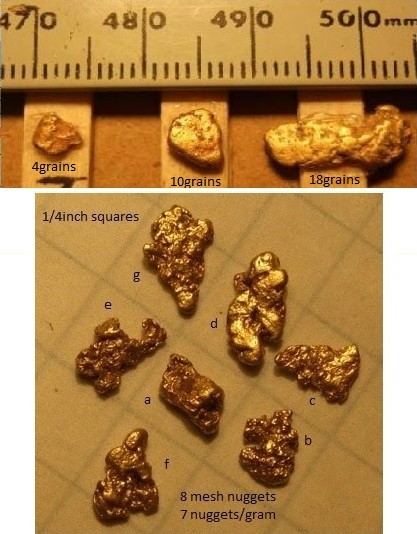
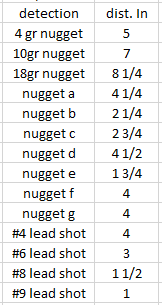
-
 2
2
-
-
-
Try a standard Bic plastic ball point pen medium tip - small brass tip with 1mm tungsten carbide ball. Steve Herschbach has used it for years as a standard for testing gold detectors - also easy to stick in the sand and hard to lose. - and, of course available everywhere.
Google Steve Herschbach bic pen and read what he has to say about it. It apparently behaves a very low conductive target. It presents in interesting test of the cut-off setting of a detector with iron discrimination - Might ve interesting for Manta
Here’s the results one guy got with his nugget detector on various targets (the POINT - lol - is to show how tough a target the pen tip is....)
”Bic Pen-3/4" 1/2 Grain (not gram) nugget 1" 1.3 gram nugget 5" . One tenth oz gold coin 8 1/2".. from Finds Technology ForumWhen I saw this posted the first time I tested some ball point pens from motels I had stayed at. Didn't have a Bic. Pen A(3.5us time constant) pen B(2.2us time constant) pen C(.65us time constant). Saw reply again the other day. Found Dollar General had 10 BiC Round Stic medium pens for a dollar, 1mm tungsten carbide ball. BiC(2.1us time constant). Charts a little less than a 4grain nugget I have. Wondering why test above has BiC pen closer to 1/2grain nugget than a 4grain nugget. Maybe missing I'm something. Thought I would go to the source to ask. The time constant of ball point pens can vary a lot, wondering if the one I used is the same as used in the test above. Does look like a BiC Round Stic medium tip would make a good test target.
-
 2
2
-
-
If the ID is close to a nickel, my guess is Titanium 6AL-4V
-
4 hours ago, Goldseeker5000 said:
What exactly are you trying to prove?
Trying to learn something. Didn't have an idea how fast smaller nugget signal decayed. Have asked before in another forum and always got the answer, to much variation. Wanted to know how small a nugget a good PI detector could detect to get some for testing.
18 hours ago, GB_Amateur said:How do you determine these values? (I can see the graphs, but please explain how the graphs lead you to these values.)
I made a PI circuit. Tx coil, Rx coil, control circuit, amplifier looking at Rx and log amplifier looking at amplifier out. Record log amplifier out vs time and chart. Most targets with a time constant<10usec decay straight line on a linear log chart. Loose 63% of signal every time constant, loose 90%(decade on chart)) every 2.3 time constants, loose 50% every 3 small divisions on chart. A eight inch coil could loose 3 to 4 inch detection distance for every decade lose in signal. The shorter the time constant the sooner the need to sample. Probably need a smaller coil to get a good chart for the 8mesh nuggets, data below the 0 line(1% 0f full scale amplifier out)starts to be effected by noise when charting. Added a 1 and 2usec time constant decay line on chart to compare target decay with, most nuggets decay with a slope between the two lines.
-
 2
2
-
 1
1
-
-
-
Received 8mesh nuggets. For a quick test I charted all the nuggets at same time(side by side flat not touching)to see how much signal. Should give average time constant. Decay time constant 1.7usec, good signal, think I can test them one at a time flat. TC on edge might be to low. Anyone familiar with small nuggets, do they look like what you would expect?
-
 2
2
-
-
I just weighed a few 8 mesh nuggets, and they were from 1 grain to 4 grains in weight. That will definitely present a challenge to a PI, with some probably being detectable with a hot PI, and some not. Just depends on the above factors.
Looks like 8 mesh answers my question. Thanks for all the other information.
Including a picture with test results for three nuggets I have. Charted decay amplitude after PI Tx off(zero time). 10grain nugget has a higher TC than 18grain nugget.
-
 5
5
-
-
I've been trying to make a PI detector as a learning exercise in another forum(Geotech). Asked the question below but haven't got a reply. Maybe someone here could answer the question.
Nugget sizing info:
We are often asked how many pieces per gram or ounce. It is very hard to predict how many pieces there are per gram or ounce as the # of nuggets by weight varies quite a bit per batch. But in general you can expect around 1-2 pieces of gold for 4 mesh, 2-4 pieces of 6 mesh per gram, 7-12 pieces of 8 mesh per gram and around 15-20 per gram for 10 mesh. You can expect many more pieces for smaller 12 (around 20-25), 14-16 (around 30-50 or more) pieces and hundreds for fine gold. Every batch is very different and each piece of gold is natural and of course therefore unique. Some may be flat and light or rounded and very dense (heavy).
How small a nugget can a good PI detect? What mesh size would make good test targets for smaller nuggets? 8 mesh, 10 mesh, both or other?
Any guess on typical TC for 8 or 10 mesh nuggets?

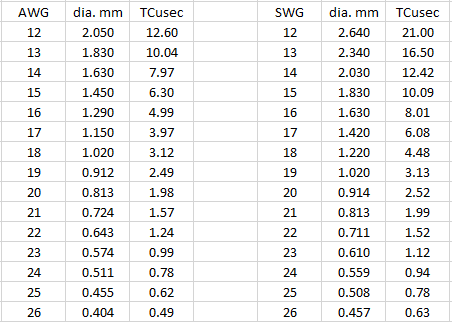


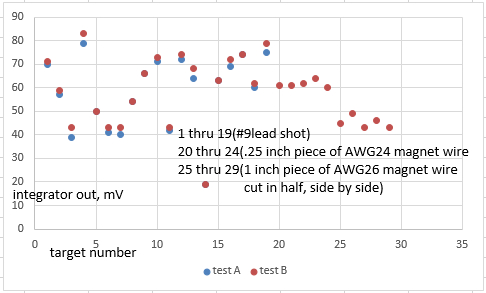
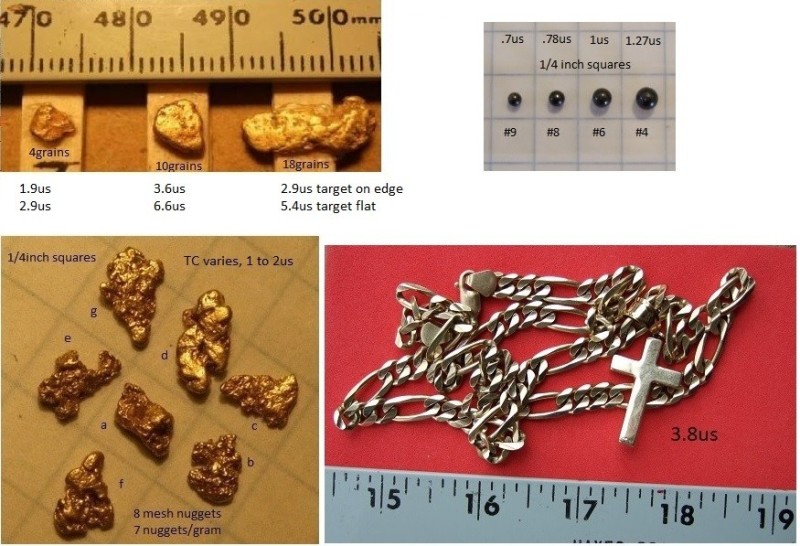

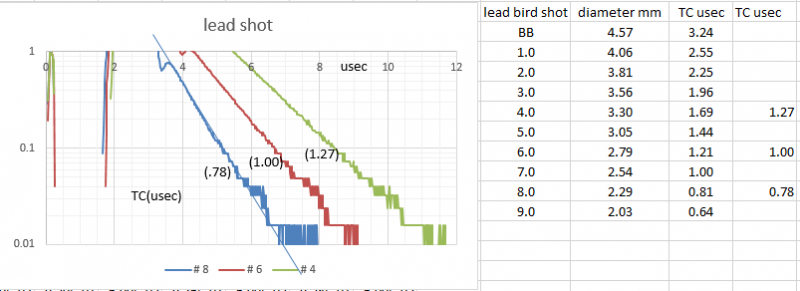

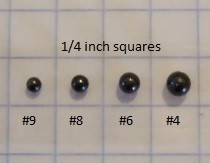
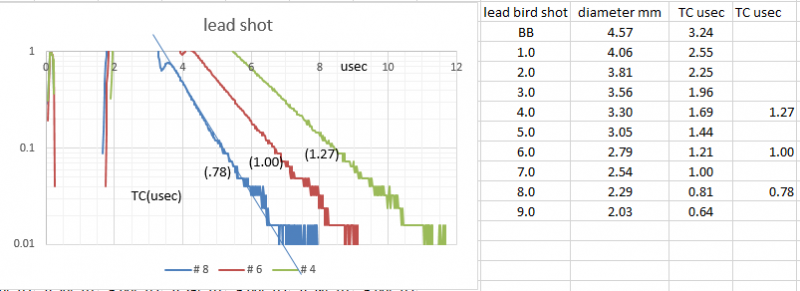
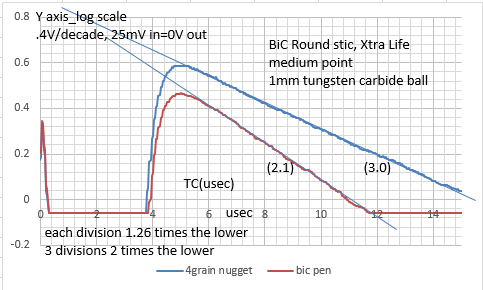
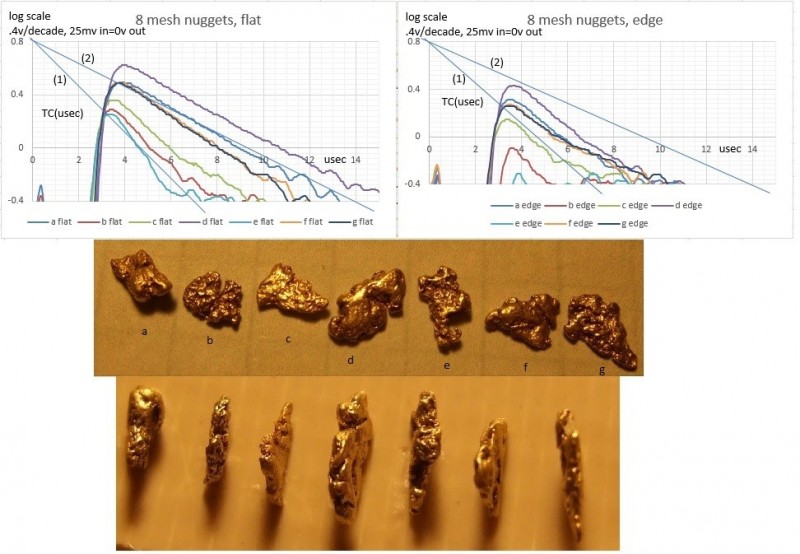
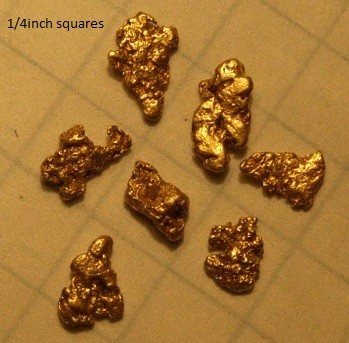
#9 Lead Shot
in Metal Detector Advice & Comparisons
Posted
I purchased one gram of nuggets awhile back. Seven pieces/gram, time constant varied between 1 and 2 us. Thinking .03g nugget has a time constant less than 1us. I liked #9 shot since size and time constant (about .7us) should be similar to nuggets less than .1g until I found they weren't consistent. A 10mm square piece of aluminum foil has a time constant of .7us but is easily detected because of size. Standard target needs a time constant between .5us and 1us and a size that gives a detection distance similar to a small nugget less than .1g. I like the wire but if anyone can find a consistent sphere target with a time constant around .7us with a size similar to a small nugget all the better.